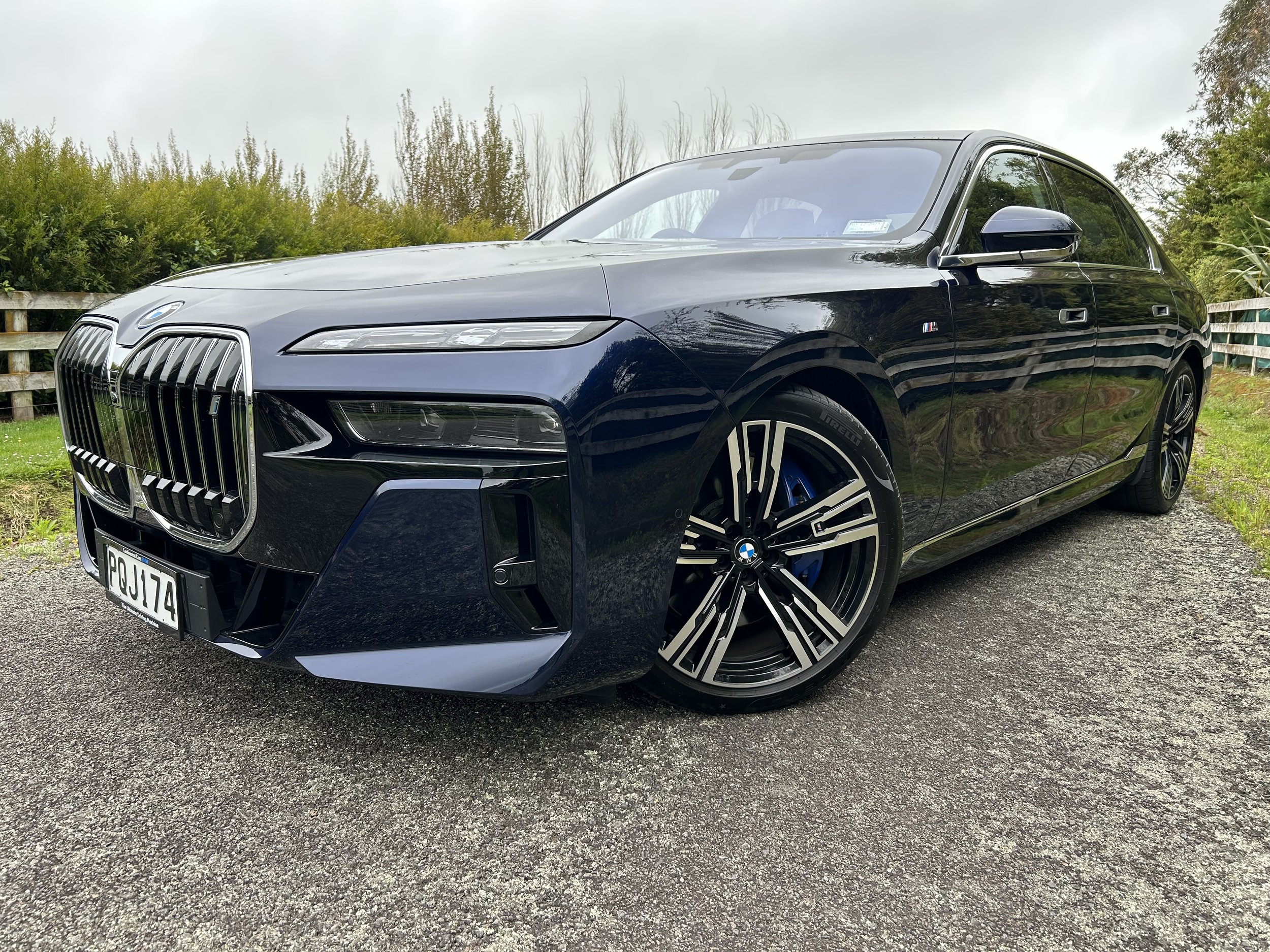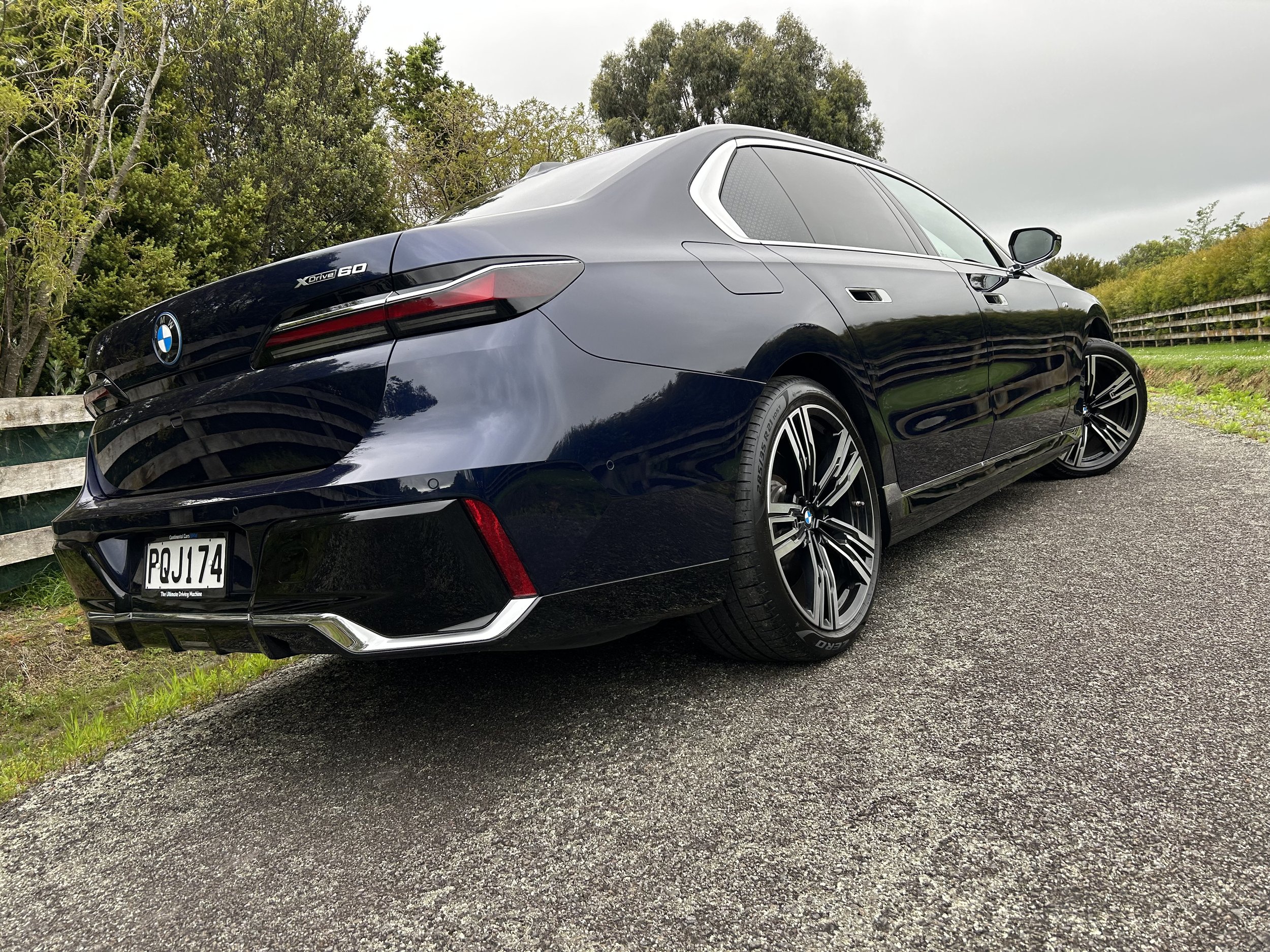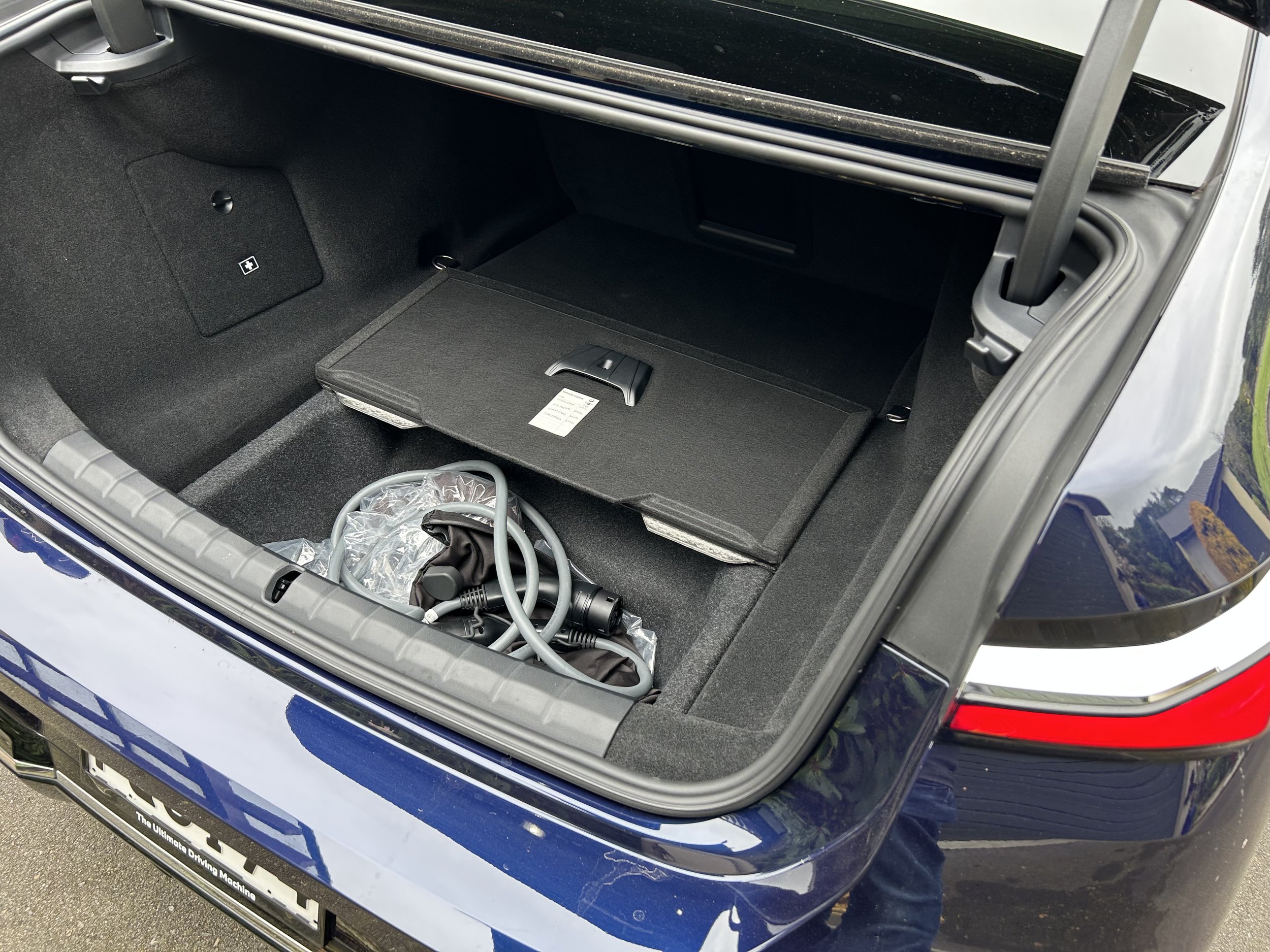BMW i7 xDrive60 roadtest review: Easy vote for change
/Munich’s flagship is the ultimate expression on the campaign trail for battery purity.
Price: $276,600
Powertrain and economy: Dual electric motor, 400kW/745Nm, 19kWh/100km energy use, 101.7 net battery, up to 624km range WLTP.
Vital statistics: 5390mm long, 1544mm high, 1950mm wide, 3215mm wheelbase, 21-inch wheels.
We like: Astoundingly impressive technology expression; impressive to drive; probably just as good to be driven in.
Not so much: At the limit for length; sobering depreciation prospect.
DRIVING around or being driven around; passenger or pilot?
The big question in respect the luxury limo experience demands urgent attention with the BMW i7.
The loan agreement allowing a week with the xDrive60, which has two motors for all-wheel drive fed by a 106.5kWh gross (101.5 net) battery and generating 400kW/745Nm and around 600 kilometres’ driving, if you’re soft on the pedal, decided. No-one but the assigned user to drive.
For me, then, testing how the other half fare in this ‘best car to drive, best car to be driven in' pitch was motionless mission. No worries. The luxury functions still work regardless.
Wishful thinkers might hope there will be a day when the astounding technology load was just that little bit smarter still, to enable fulfilment of the full autonomy dream.
As is, an i7 is close, but not yet able. In a way, that’s a good thing. As much as self-driving - assuming it could ever be made truly failsafe - would conceivably allow equal enjoyment of the facilities for everyone on board, in this case it would also be a shame, the hands-on driving is actually really good.
Sevens have always been big and they’ve always looked bulky, and adding in a huge battery under the floor only adds to this - as I understand it, an electric i7 seems is almost as heavy as the old fossil-fuelled armoured examples. But would you know this from behind the wheel? In the most part, this car conspires to make light of its load. The car not only having hood turn of pace but also being lithesome reminds the M logo it wears isn’t just is respect to the styling package.
As the guy who broke the story, I’m fully aware that talking about the i7 and the potential about it becoming a future Government limo is a subject to be handled with care. All the same, my own experience has raised by confidence that those professional drivers here who know the previous generations of 7-Series extremely well, in their capacity as employees of Government Crown VIP fleet, will - if ever given the chance - just love the i7. One particular element especially tailors to their skillset. Ability to effect fully smooth starts and stops is a talent that marks out a pedigree driver. It’s harder than it sounds. Except in an i7, which is ultra-schmoozy at both.
So if Government gets it, who else is in line? Embassy duty and high-end hotel service doubtless avails. Private owners?
Sevens have traditionally been low volume home driveway occupants; everyone prefers SUVs and, perhaps, also the astonishing depreciation plummet big luxury sedans have long copped also comes into it.
But maybe this one’s Green goodness elevates that chance. There’s definitely something a bit grin-worthy about a car that, while eye-waveringly expensive, is relatively cheap as chips to run. It’s a heck of a thing to be able to quietly share that the near-empty-to-full replenishment cost for this might be one tenth the cost of filling the petrol equivalent.
This car availing all its fab functions while it’s parked up, using the facilities it offers, by using the 101kWh drive battery as a big power bank is brilliant; on a petrol, just running the air con alone would ask for the engine to be burning fuel. Here there was no issue with me putting in a good hour of deep-dive button-pushing (a not wholly accurate descriptive, as many controls are touch sensitive). Mucking about with the stereo, running the curtains up and down, even setting the seats in massage mode seemed to make for negligible battery drain. Maybe it would be different had the car featured the ultimate option, ’BMW Theatre Screen' - a 31-inch touchscreen entertainment system for the rear seats that swings down from the roof.
More than all its glam touches draw attention to the i7 being an expression of absolute luxury. It basically shouts out its expensiveness. BMWs latest styling is bold; it goes larger still on a car this big. A Seven is low, but longer than a one-tonne ute. That, and its width, lend as much as the usual large grille to an air of authoritative, commanding importance.
When you’re driving, it’s essentially like any other modern BMW. You can achieve drive away operability in a minute. To really learn it? Expect that to far more of a challenge. There’s a tsunami of tech in an ocean of opulence.
Initial priority was to deactivate the rear door child locks (quite simple, yet much easier sorted by YouTubing than deciphering the handbook), a prelude to setting up the key fob so to enable the ultimate attention-nabbing trick; making all four doors auto open and close at the press of a button or on and in-car touchpoint.
That function, one presumes, is to keep alive familial tradition for this giant sedan to be the runway for new tech set to filter through to less costly cars. Assuming there’s perceived need .… and, I dunno, really.
The engineering is amazing, but is as perhaps as pointless as it is pretentious, given the safeguards it demands to avoid opening into traffic or any solid object. Or even a person. The hotel concierge who wishes to use the external touch button to activate the sequence will need to stand obliquely, else nothing will happen and you’ll look a bit foolish to your wife who says she just wants to get out, cannot be bothered with all the faff so ruins the whole marvellous theatre by hefting on the traditional opener.
In respect to tech, the car seems prepared to only fully awaken its complete repertoire when hooked into the ‘My BMW’ app, which is owner-oriented and requires an account (though no credit card details, I hasten to add). This enables your phone (or iPad) to become a surrogate device to lock and unlock the car, plus pre-set the a/c, check the battery state of charge and all the other stuff that comes with this level of link.
You can make your phone a key, supplementing those BMW supplies, though that requires a higher level of access than could be managed with the press car. I hadn’t intended to bother with the app, but found it was requisite to ensuring seamless operation of Apple CarPlay, which had been cutting out for no fathomable reason until then, but never hiccuped from thereon. BTW, all that is wireless, but it does have USB-C sockets, two up front in the armrest storage box, those in the rear built into the back of the front seats, under a little sliding cover.
The screens are controlled by a mixture of voice, touch, steering wheel buttons plus the usual iDrive click-wheel down on the centre console.
The big screen across the dash is actually two, cleverly integrated displays; the one in front of the driver showing all functions relevant to driving; the other everything else. Interestingly, the console display only entertains minimal alteration - quite different to the Benz way, in which you get multiple instrument screen options.
The main infotainment setup delivers many, many menu items, all presented as apps. There’s likely a way of sorting them into a personal priority order; it’s one thing I should have done, but didn’t. The main heating and ventilation controls are on the screen at all times, thankfully, and the lights and wipers are set to auto unless you otherwise decide.
Fathoming how to get the headlights to go onto a smart auto-dip seemed a faff; you’d think it’d be on the bespoke control panel but instead it’s actually an app. Apologies to all I blinded on my first after-dark excursion, which I thought I had the lamps on auto dip, but instead had effected the exact opposite. Once remedied, it was spectacular. The good thing is that the car remembers all the settings from any previous outing, so once you’ve sorted this the first time, there’s no need to go back again.
A base factory form provisions an electric boot lid, auto-dimming mirrors, the 'Iconic Glow' light-up grille, soft-close doors, the curved dashboard display that joins the 12.3-inch instrument panel and the 14.9-inch infotainment screen together, front and rear heated seats, Merino leather upholstery and four-zone climate control. Stop to take breath. Continue. … and a Bowers and Wilkins sound system, active cruise control with braking, the 'BMW Interaction Bar', a head-up display and adaptive LED headlights. It wasn’t good enough for Kiwis.
We take the M Sport Pro package, so auto front and rear doors, massaging front and rear seats, rear electric blinds, the 'Sky Lounge' panoramic glass roof (which includes LED lighting elements), ventilated front and rear seats plus the visual impact enhancements of 20-inch 'M Aero' alloy wheels, black exterior trim instead of chrome, BMW's 'Iconic Sounds Electric' sound effects, an M leather steering wheel and M Sport brakes with dark blue calipers.
Sporty stuff can be abetted by sporty sounds, created by a certain famous electronic music genius, but you’re dabble then deactivate: The sound of silicon is best. At 100kmh on normal seal this car is so well insulated you can hear, but only just, the air circulating through dashboard vents, which are so hidden in the structure of the dash you have to presume they exist.
Rendered from an imitation cut-glass crystal are the i-Drive controller, electric seat controls (mounted on the doors) and the BMW Interaction Bar, which runs the full width of the dash and into the door panels and lights up according to the driving mode you've selected. It can also flash warnings such as collision avoidance, or just that you've turned the hazard lights on. A touch gauche? It’s definitely a statement piece. Gaining more ooh-aah attention from my Seven owner mates was the complex and beautifully-wrought piece of turned and sliced aluminium that covers over the speakers for the brilliant stereo.
You’ll be tempted, as I was, to use the car as sumptuous retreat from life’s realities. The Seven is the basis for the first electric Rolls Royce, the two-door Sceptre. The latter will doubtless pit the BMW into a lower social class, but in isolation Munich’s machine is the o ne to bow and scrape to. It is remarkably complete in respect to comfort.
Front seats more comfortable and supportive than the high-end Scandinavian arm chairs we have in our lounge are bettered by the rear chairs. They be electrically adjusted, using one of the 5.5-inch phone-style touchscreens built into the door panels, to make best use of a space that’s larger now than it was in the old long wheelbase Seven.
If you're in the left-hand rear seat, and no-one's sitting in the front passenger seat, then you can push a button that converts the rear into a club-class airline style lie-flat (well, almost flat) seat allowing you to fully recline with your legs stretched out. In hindsight, there’s where I should have been sitting whenever the car was being recharged.
Ironically, for all the space, the one wee flaw of the cabin is relatively modest oddments capacity; some of the cubbies are quite small. Also, with a capacity of 500 litres, the boot might not seem quite as commodious as you might imagine, considering what a behemoth the i7 is. It does have a handy under-floor storage area in which the charging cable stashes.
At time of review, the i7 had not yet been independently tested by Euro NCAP, but it shares a great deal with the iX SUV, and that scored a full five-star rating. It has a very comprehensive driver monitoring system and collision preparation (which tightens the seatbelts and winds up the windows). Crossing traffic warning, a blind-spot monitor and tyre pressure sensors also feature. There’s also an exterior acoustic sound that warns peasants … sorry, pedestrians …. of the car’s approach at low speeds.
In respect to the performance side? Well, it’s built for pace. The ‘M’ in BMW is ‘Motoren’ - a reminder that this brand has always maintained that a good engine is the heart of a good car.
The i7 is another electric BMW that shows that view also holds for battery-fed motors; BMW’s are pretty good for quietness and energy. The power output is impressive, but even though the torque isn’t as strong as that from the rival Mercedes Benz, it still very much does the business. This isn’t a GT car - everything is about panache so the oomph doesn’t so much unload with a wallop as uncoil in measured fashion - but you’re in no doubt it has a lot of it. If you want extra then it just throws more in, with no sense it’s having to scrape the barrel for it.
And that’ll all before resorting to the 'Boost' mode, which is there for ‘full steam ahead’ requirement. It’s to be used with prudence. There’s good reason why the dashboard flash red when you tug the single paddle behind the steering wheel. The additional punch released only avails for 10 seconds, but that’s quite enough. There’s little need for it in daily open road driving, where it will simply sail along.
Is there anything else quite like it? The Mercedes EQS patently matches up closest in its AMG 53 form. It costs around $20k more, but has more grunt, around the same range, is equally opulent - though has fewer toys - and, unlike the i7, presents in a body that it not shared with a fossil fuelled car. In the Seven camp, the petrol (which is not hybrid) and electric editions are lookalikes, save the battery car has a closed nose and lacks exhaust pipes.
The Benz is also a mightily impressive car. But it’s not exactly the same. The biggest difference in their operability could come down to driving feel. With both, you’re always aware of their sheer size and considerable weight and cognisant of how vital their fat performance rubber and all-wheel-drive is.
Both brands have gone to their sports divisions to help deliver the cars, but the imprint AMG makes on the EQS is more pronounced than that from M Division for i7. The i7 certainly doesn’t seem to be caught out in quick cornering snd I suspect it’ll deliver a sharper starting feel, yet the EQS is potentially the sportier, more agile car still.
However, that dynamic edge affects an element high profile passengers would consider requisite: Ride comfort. On anything other than a smooth tarmac, the AMG evidences a degree of annoying brittleness. The i7 is much better at quelling the sound and feel of a coarse chip surface. For optimal quiet and plush, I’d actually commend trying the 'Efficient' driving mode. Though acceleration is detuned a bit, it still rolls along with fantastic purpose and imperious decorum.
It also sashays nicely the urban-sphere, but of course that’s also when its size really hits home. As grateful as you are for all its sensors and assists - not least the rear-wheel steering - this is a car you’ll always take care to park at the quiet end of a shopping centre, though also in a well-lit spot. My closest local rechargers both demand parking at 90 degrees to the kerb. The BMW’s port is conveniently at the back, driver’s side, so it’s easy enough to place, but as the photo shows, in doing so at one street side location it did leave the nose jutting perilously close to the traffic stream.
In respect to replenishment, you’ll seeking out 300kW hypercharger locations, because even the more regular 50kW outlets will require hooking up for at least an hour to deliver tangible range. With the big banger charger, you could conceivably use the function, selected on the main touchscreen, that preps the battery to achieve the quoted 195kW charging speed, only slowing down once above 80 percent state of charge.
Obviously, most people reading this won’t be doing so with thought about purchase. I’ve friends who favour Seven ownership … but they always buy them used, when even those that are well cared for and low mileage fetch but a fraction of the as-new price. Of course, the used car market only exists because someone else has taken the plunge. For the record, they were very impressed by this one. I imagine they might take the plunge around 2030.
Volume aspiration is not the point of this car. The Seven exists for the same reason all others in the six-star category do … to presents chance to show one-upmanship and to lend, as said, first glimpse to gear that will often infiltrate into less expensive models after a while.
The i7 is hardly a be-all for everyone, but in its primary role, it is an astounding car, with refinement and comfort levels that are pretty well second to none, plus technology that, for the most part, will not so much mess with your brain as simply blow your mind. Beyond that, it is such a powerhouse for the electric ideal you wonder why they even bother to sell it with petrol.
If Government does buy in, they can count themselves well-served. I’d be tempted to run for office on strength on what it offers.
























